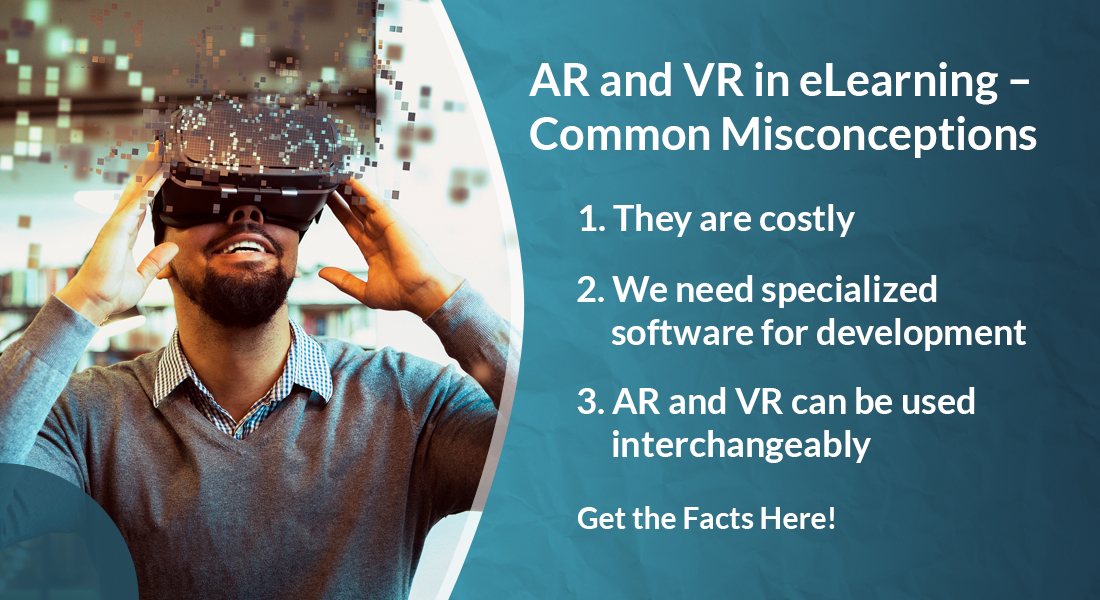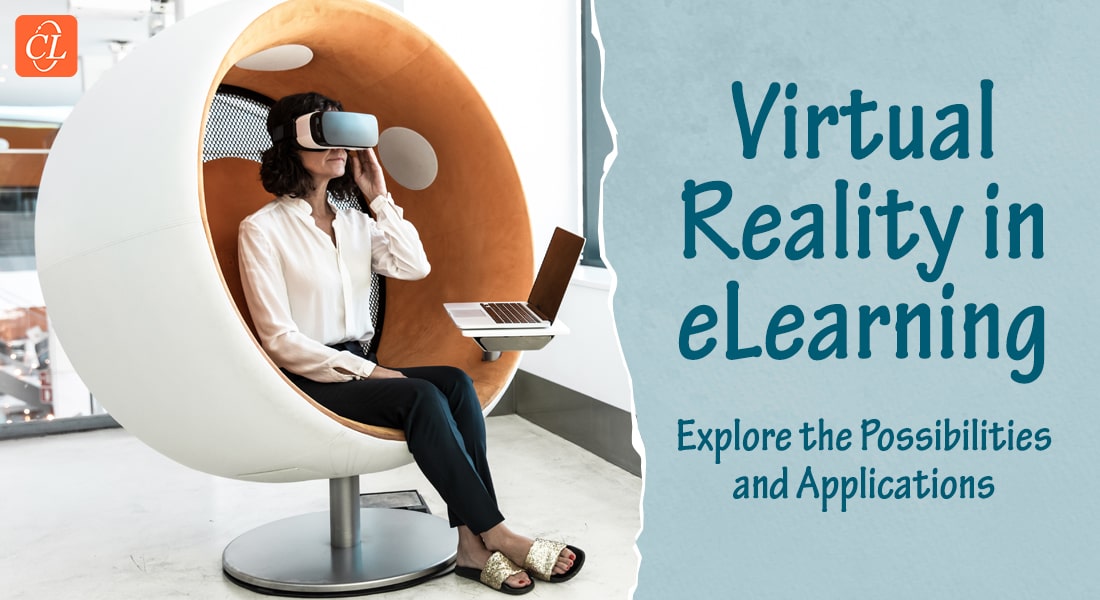Debunking 4 AR and VR Misconceptions in eLearning
Augmented Reality (AR) and Virtual Reality (VR) are trending immersive learning strategies. However, since they are relatively new in the L&D space, there are a number of myths about AR and VR that we will debunk in this blog!

Confused about Augmented Reality (AR) and Virtual Reality (VR)? Wondering about their role in immersive learning? This blog aims to debunk 4 myths of AR and VR-based eLearning and give you a clear idea of how they help offer immersive learning! But before we start debunking these myths, let’s understand what immersive learning really means.
Common AR and VR Misconceptions in eLearning – Dispelled!
- AR and VR are not the same
- They are not costly, nor do we need specialized development software, thanks to authoring tools!
What is Immersive Learning?
Immersive learning is a learning strategy that puts your learners in a highly interactive learning environment, – either physical or virtual. It mimics real-life scenarios to teach specific skills and techniques, making your learners active participants in the learning process. In other words, it is learning through experiences where learners get to experience real-life situations in a risk-free environment with immediate feedback.
Immersive learning is not a new term in the online training space. It has become one of the most successful ways of training employees over the years and is definitely here to stay! But does that mean there is only one way of immersive learning? Certainly not! Simulations, scenarios, game-based courses have been used as popular immersive learning strategies; however, AR and VR have managed to direct the attention of the L&D space more recently.
Be it immersive learning or game-based courses, explore how rapid eLearning can help in quick rollout.
Busting 5 Common Myths about AR and VR
Now that we understand the basics of immersive learning, let’s take a look at 5 common misconceptions about AR and VR based eLearning courses:
1. AR and VR Can Be Used Interchangeably
People often get confused between Augmented Reality (AR) and Virtual Reality (VR). They are NOT the same and CANNOT be used interchangeably. Both AR and VR play a huge role in immersive learning. Let’s understand the difference between the two.
Virtual Reality (VR)
- It is a complete immersive experience that shuts out the physical world. In other words, it creates a replica of the real world.
- Video games and driving simulators are good examples.
- It uses opaque headsets.
Augmented Reality (AR)
- It adds digital elements to a live view. So, users can still see the actual world.
- Lenses on Instagram/Snapchat and the game Pokémon Go are good examples.
- It uses clear lenses.
Both experiences are unique and are used in different situations – different techniques of immersive learning. Deciding to use VR or AR for your training depends on the training type.
For instance, in a warehouse AR can be used to help employees navigate quickly through store aisles to get to the products that they are looking for. This increases efficiency.
VR can be used to teach employees safety and emergency procedures to be followed in a warehouse environment. The consequences of not following safety processes can be recreated in a VR environment, without real risk.
2. They are Just Not Worth the Cost!
Since AR and VR are practically new in the L&D space, it’s a general misconception that they will cost a bomb! Most organizations believe that learning through AR and VR is too expensive and therefore, it is best to stick to other methods. But these technologies are becoming more accessible and less costly – It’s completely worth the cost!
The truth is that AR and VR, if used thoughtfully, can help reduce costs and give your organization a high ROI in the long run. In fact, today we have multiple authoring tools that facilitate AR and VR learning at a relatively low cost. For example, CenarioVR (an authoring tool that is a part of Trivantis suite), allows you to create VR simulations, quick and hassle-free.
AR and VR-based courses save cost by increasing the level of safety
AR and VR give learners the opportunity to interact with 3D models and simulated environments which provide a safe and experiential learning space. In simple words, there is no risk to your organization, there is no risk to your learners, and there is no risk of an employee damaging actual equipment – which certainly takes away a lot of load from already dwindling training budgets.
For example, pilots who are being trained are first asked to do a test using flight simulations until they are ready for the real experience. The healthcare sector can benefit greatly from VR training since it can help physicians learn how to perform surgeries virtually, rather than on a real patient. The heavy machinery sector is now training their employees on operating machinery using VR. This ensures their safety and it is possible to repeat the training regularly without the additional cost of equipment or instructors.
3. You Need Specialized Tools to Support AR and VR Course Creation
It is a common misconception that you need specialized tools to create AR and VR-based eLearning courses. However, you will be surprised to know how much some eLearning authoring tools can achieve in terms of AR and VR course creation. Today, there are a number of advanced authoring tools that can facilitate the creation of AR and VR-based courses (such as Adobe Captivate 2019, CenarioVR). Let’s take a closer look at some of the authoring tools that can be used to create AR and VR based courses:
Adobe Captivate 2019
This rapid authoring tool provides interactivities (markers, hotspots), an intuitive user interface, and 360° media assets that are required to develop AR and VR. 360° learning assets (images and videos) can be used with overlays to augment learning landscapes. These assets capture real world experiences and offer immersive playback.
CenarioVR
This online authoring tool by Trivantis is a favorite when it comes to creation of VR simulations. It allows learners to experience a 360-degree virtual environment while they learn. The tool supports 2D embedded videos, branching scenarios and dynamic feedback for impactful immersive learning experience.
4. Immersive Learning Can Only Happen Through VR and AR
Like I mentioned in the beginning, Virtual Reality (VR) and Augmented Reality (AR) are not the only way to achieve immersive learning. The level of immersive learning depends on the need, content type and infrastructure availability.
Simulations
Simulations are a remarkably effective way of immersive learning since they mimic real-life situations and allow learners to practice and explore in a risk-free environment. For example, people training to become law keepers can learn how to navigate through hostage situations using eLearning simulations. The military too uses simulations to create battle scenarios for initial training. Software simulations can be used to train employees on a new software or ERP system.
eLearning simulations can consist of three modes that allow the learner to learn through a step by step procedure. They are:
- Watch: learners are given a step by step demonstration of how to perform a task
- Try: learners are expected to try executing the task with the help of hints/guides
- Do: learners have to successfully perform the task with no assistance)
Game-Based Courses
You can create highly interactive game-based courses where the learners are expected to play games in order to learn. Such games add a fun element to the process of learning by involving the learners and giving them tasks at different levels, and allowing them to make decisions to move forward.
For example, an online treasure hunt is a creative way of getting the learner to actively participate in reading and solving issues in the form of clues/puzzles with an end goal. In short, game-based eLearning courses invoke competitiveness and immerse learners in learning.
Scenario-Based Learning
You can create scenarios, stories or narratives that are animated and highly entertaining to watch. These scenarios can be a way of learning lessons and understanding how to solve problems as per the situation. For example, the course can consist of a Q&A scenario of a client trying to buy a product from the learner, where the learner has to answer all the client’s questions and provide them with the product they require.
Wrapping it Up!
COVID-19 has turned our lives upside down. Organizations need innovative eLearning techniques now more than ever. So, this is the best time to leverage the power of immersive learning for the benefit of your employees and your organization. The myths regarding AR and VR have been busted and the benefits have been made clear. Worry no more and enjoy the immersive learning experience!
If you want to learn more about the latest eLearning trends, take a look at our eBook!





